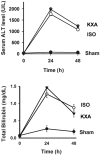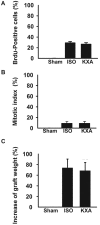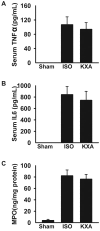Ketamine-xylazine-acepromazine compared with isoflurane for anesthesia during liver transplantation in rodents
- PMID: 20122316
- PMCID: PMC2824967
Ketamine-xylazine-acepromazine compared with isoflurane for anesthesia during liver transplantation in rodents
Abstract
Orthotopic liver transplantation in mice and rats is used to study a wide range of scientific questions. Inhalant anesthesia is widely used in liver transplantation models in rodents, but drawbacks of inhalant anesthetics include issues of cost, safety, and ease of use. The goal here was to find an effective injection anesthesia protocol that would not directly influence metabolic or functional parameters after liver transplantation. We compared intraperitoneal injection of a ketamine-xylazine-acepromazine cocktail (KXA) with isoflurane during 50% liver transplantation in mice and rats. Anesthesia with KXA had rapid induction (5 +/- 3 min) and a long duration of surgical anesthesia (70 +/- 10 min). The 2 methods of anesthesia produced no significant differences in liver injury (histology, serum alanine aminotransferase and total bilirubin concentrations), inflammation (IL6, TNFalpha, myeloperoxidase activity), regeneration (incorporation of 5-bromo-2'-deoxyuridine, mitotic index, restitution of liver weight), or 7-d survival. In conclusion, a KXA regimen is a safe and effective injectable anesthetic for rodent liver transplantation and is a suitable substitute for currently used inhalant anesthesia. Injectable anesthetics offer advantages in terms of cost, personal safety, and ease of use and will be particularly beneficial to microsurgeons during their training period in liver transplantation.
Figures





Similar articles
-
Intraperitoneal Continuous-Rate Infusion for the Maintenance of Anesthesia in Laboratory Mice (Mus musculus).J Am Assoc Lab Anim Sci. 2016;55(5):548-57. J Am Assoc Lab Anim Sci. 2016. PMID: 27657709 Free PMC article.
-
Optimization of intraperitoneal injection anesthesia in mice: drugs, dosages, adverse effects, and anesthesia depth.Comp Med. 2001 Oct;51(5):443-56. Comp Med. 2001. PMID: 11924805
-
Assessment of unassisted recovery from repeated general isoflurane anesthesia in horses following post-anesthetic administration of xylazine or acepromazine or a combination of xylazine and ketamine.Vet Anaesth Analg. 2013 Jan;40(1):3-12. doi: 10.1111/j.1467-2995.2012.00782.x. Epub 2012 Sep 27. Vet Anaesth Analg. 2013. PMID: 23016627 Clinical Trial.
-
Safety and efficacy of various combinations of injectable anesthetics in BALB/c mice.J Am Assoc Lab Anim Sci. 2008 Jan;47(1):11-7. J Am Assoc Lab Anim Sci. 2008. PMID: 18210992 Free PMC article. Clinical Trial.
-
Effect of Anesthesia on Intraocular Pressure Measured With Continuous Wireless Telemetry in Nonhuman Primates.Invest Ophthalmol Vis Sci. 2019 Sep 3;60(12):3830-3834. doi: 10.1167/iovs.19-27758. Invest Ophthalmol Vis Sci. 2019. PMID: 31529079 Free PMC article.
Cited by
-
Tiletamine/zolazepam and dexmedetomidine with tramadol provide effective general anesthesia in rats.Animal Model Exp Med. 2021 Jan 2;4(1):40-46. doi: 10.1002/ame2.12143. eCollection 2021 Mar. Animal Model Exp Med. 2021. PMID: 33738435 Free PMC article.
-
Murine Aseptic Surgical Model of Femoral Atrophic Nonunion.MethodsX. 2020 Apr 21;7:100898. doi: 10.1016/j.mex.2020.100898. eCollection 2020. MethodsX. 2020. PMID: 32382524 Free PMC article.
-
Morphine self-administration is inhibited by the antioxidant N-acetylcysteine and the anti-inflammatory ibudilast; an effect enhanced by their co-administration.PLoS One. 2024 Oct 29;19(10):e0312828. doi: 10.1371/journal.pone.0312828. eCollection 2024. PLoS One. 2024. PMID: 39471200 Free PMC article.
-
Complement Inhibition Alleviates Cholestatic Liver Injury Through Mediating Macrophage Infiltration and Function in Mice.Front Immunol. 2022 Jan 7;12:785287. doi: 10.3389/fimmu.2021.785287. eCollection 2021. Front Immunol. 2022. PMID: 35069557 Free PMC article.
-
Apoptosis induced by a low-carbohydrate and high-protein diet in rat livers.World J Gastroenterol. 2016 Jun 14;22(22):5165-72. doi: 10.3748/wjg.v22.i22.5165. World J Gastroenterol. 2016. PMID: 27298559 Free PMC article.
References
-
- Arras M, Autenried P, Rettich A, Spaeni D, Rulicke T. 2001. Optimization of intraperitoneal injection anesthesia in mice: drugs, dosages, adverse effects, and anesthesia depth. Comp Med 51:443–456 - PubMed
-
- Asokan R, Hua J, Young KA, Gould HJ, Hannan JP, Kraus DM, Szakonyi G, Grundy GJ, Chen XS, Crow MK, Holers VM. 2006. Characterization of human complement receptor type 2 (CR2/CD21) as a receptor for IFNα: a potential role in systemic lupus erythematosus. J Immunol 177:383–394 - PubMed
-
- Bovill JG. 2008. Inhalation anaesthesia: from diethyl ether to xenon. Handb Exp Pharmacol 182:121–142 - PubMed
-
- Conzelmann LO, Zhong Z, Bunzendahl H, Wheeler MD, Lemasters JJ. 2003. Reduced-size liver transplantation in the mouse. Transplantation 76:496–501 - PubMed
Publication types
MeSH terms
Substances
Grants and funding
LinkOut - more resources
Full Text Sources
Research Materials
